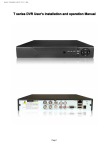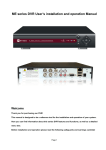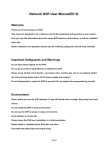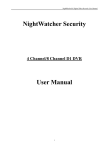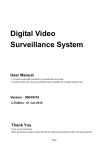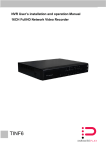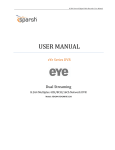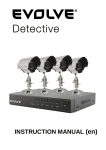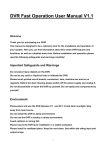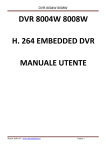Download DVR User Manual - Digital Watch USA
Transcript
1 DWU-4DE-H18 & DWU-8DE-H55 DVR User Manual Welcome Thank you for purchasing a Digital Watch USA video surveillance system. This manual is only a reference tool for the installation and operation of your system. Before installing anything, please follow the guidelines to properly connect your DVR and pay attention to the warnings listed below. Now, let’s take a moment to go through the features of your DVR. Warnings Do not open the DVR case(except to install/swap the hard drive), never open the case when the DVR is powered on. Only use the power adapter supplied. Make sure the DVR is in a well ventilated space and avoid dusty or humid locations. Protect your DVR against sudden bumps or shocks. Avoid direct sunlight, place the DVR away from direct heat sources and operate the DVR in a temperated location (0℃ ~ 40℃). Page 1 2 Contents 1 Introduction .............................................................................................................................................. 4 1.1 Product overview ........................................................................................................................... 4 1.2 Main features ................................................................................................................................. 4 2 Open-box and cable connections ............................................................................................................ 5 2.1 Open-box ..................................................................................................................................... 5 2.2 Hard disk installation ..................................................................................................................... 6 2.3 Front panel..................................................................................................................................... 7 2.4 Rear panel ..................................................................................................................................... 7 2.5 Audio and video input and output connections ............................................................................. 8 2.5.1 Video input connections ...................................................................................................... 8 2.5.2 Video output connections and options ................................................................................ 8 2.5.3 Audio input........................................................................................................................... 8 2.5.4 Audio output ........................................................................................................................ 8 2.6 Alarm input and output connections .............................................................................................. 8 2.6.1 Alarm input port specification ............................................................................................ 10 2.6.2 Alarm output port specification .......................................................................................... 10 2.6.3 Alarm output port relay parameters................................................................................... 10 2.7 Speed dome connections .............................................................................................................11 3 Basic operation .......................................................................................................................................11 3.1 Turn on..........................................................................................................................................11 3.2 Turn off ..........................................................................................................................................11 3.3 System Login ............................................................................................................................... 12 3.4 Preview ........................................................................................................................................ 13 3.5 Desktop shortcut menu ............................................................................................................... 13 3.5.1 Main menu......................................................................................................................... 13 3.5.2 Record Mode ..................................................................................................................... 13 3.5.3 Playback ............................................................................................................................ 14 3.5.4 PTZ Control ....................................................................................................................... 14 3.5.5 High Speed PTZ ................................................................................................................ 24 3.5.6 Alarm Output ..................................................................................................................... 24 3.5.7 Color Settings .................................................................................................................... 24 3.5.8 Output Adjust ..................................................................................................................... 25 3.5.9 Logout ............................................................................................................................... 25 3.5.10 Window Switch................................................................................................................26 4 Main menu ............................................................................................................................................. 27 4.1 Main menu navigation ................................................................................................................. 27 4.2 Record ......................................................................................................................................... 29 4.2.1 Record Config ................................................................................................................... 29 4.2.2 Playback ............................................................................................................................ 31 4.2.3 Backup .............................................................................................................................. 33 4.3 Alarm ............................................................................................................................................ 35 4.3.1 Motion Detect .................................................................................................................... 35 4.3.2 Video Blind ........................................................................................................................ 38 4.3.3 Video Loss ......................................................................................................................... 38 Page 2 3 4.3.4 Alarm input ........................................................................................................................ 39 4.3.5 Alarm output ...................................................................................................................... 40 4.3.6 Abnormality........................................................................................................................ 40 4.4 System ......................................................................................................................................... 41 4.4.1 General .............................................................................................................................. 41 4.4.2 Encode .............................................................................................................................. 43 4.4.3 Network ............................................................................................................................. 44 4.4.4 NetSevice .......................................................................................................................... 45 4.4.5 GUI Display ....................................................................................................................... 52 4.4.6 Account .............................................................................................................................. 54 4.4.7 PTZ .................................................................................................................................... 57 4.4.8 RS232 ............................................................................................................................... 58 4.4.9 Tour...................................................................................................................................58 4.4.10 Digital..............................................................................................................................59 4.5 Advanced ..................................................................................................................................... 60 4.5.1 HDD Manage..................................................................................................................... 60 4.5.2 Upgrade............................................................................................................................. 61 4.5.3 Device Info ........................................................................................................................ 62 4.5.4 Auto Maintain..................................................................................................................... 62 4.5.5 Restore .............................................................................................................................. 63 4.5.6 Import/Export ..................................................................................................................... 63 4.5.7 Logout...............................................................................................................................63 4.6 Info ............................................................................................................................................... 64 4.6.1 HDD info ............................................................................................................................ 64 4.6.2 BPS ................................................................................................................................... 65 4.6.3 Log..................................................................................................................................... 66 4.6.4 Version .............................................................................................................................. 66 5 E-Cloud .................................................................................................................................................. 68 5.1E-Cloud PC...........................................................................................................................68 5.2 E-Cloud Smartphone...........................................................................................................69 6 FAQ & Maintainance .............................................................................................................................. 70 6.1 FAQ ...................................................................................................................................... 70 6.2 Maintainance........................................................................................................................76 Appendix 1.Remote controller operation .................................................................................................. 77 Appendix 2.Mouse operation .................................................................................................................... 78 Appendix 3.Hard disk capability calculation ............................................................................................. 79 Appendix 4.Technique parameters ........................................................................................................... 80 Page 3 4 2 Open-box and cable connections 2.1 Open-box When you receive the DVR, please verify the following: First: Please check whether there is any visible damage on the package appearance. The protective materials used for the package of DVR can protect against most of the accidental clashes during the transportation phase. Second: Please open the box and get rid of the plastic protective materials. Verify whether there is any visible damage to the appearance of DVR. Third: Please open the DVR case and check the data wires in the front panel including power wire and the connection between the hard drive and the main board. 2.2 Hard disk installation For first time use,please install the hard disk. ① Remove the case screws ④Adjust HDD position ②Disassemble the cover ③Remove screws of HDD ⑤Connect HDD data wires ⑥Screw HDD on the case Page 4 5 ⑦Cover the machine ⑧Screw the cover tight 2.3 Front panel (1) Record/1 (2) Search/2 (3)play pause/3 (4)pause/4 (5) Fast forward/5 (6) Record/6 (7) Next File/7 (8) PTZ /0 (9) Power (10)IR remoter receiver (11) Time,Record,Power,LED (13)Zoom-/8 (14) Zoom+/9 (17) Menu (18)Esc (15) Shift Page 5 (12) USB (16) Direction 6 2.4 Rear panel (1) Audio input (2) Video input (3) VGA output (4) Switch (5) Alarm input (6) Alarm output (7) 12V power output (8) Video output (9) Audio input (10) Audio output (11) Network (13) RS485 (14) Power supply (12) USB2.0 2.5 Audio and video input/output connections 2.5.1 Video input The video input port is BNC. The input signal should be PAL/NTSC BNC (1.0VP-P,75Ω). The video signal must be set according to the state’s standard: a high noise signal ratio, a low aberration and a low interference. The image must be as clear as the natural color in the appropriate brightness. 2.5.2 Video output The video output is divided into PAL/NTSC BNC (1.0VP-P,75Ω) and VGA output (Optional). If you replace the monitor by the computer display, there are some tips to keep in mind: 1、Do not turn on your monitor and keep it in a passive mode for a long time. 2、Stay away from the electro magnetic interference. TV is not a credible replacement for the video output. It is necessary to reduce the using time, control the power supply and the interference around your equipment. The creepage of low quality TV can damage other equipment. 2.5.3 Audio input The audio port is BNC. The audio signal line should be firm and away from the electro magnetic interference and properly connected to avoid false connection, joint welding and oxidation. High voltage Page 6 7 current should be avoided. 2.5.4 Audio output Normally the output parameter of your DVR audio signal is stronger than 200mv 1KΩ(BNC). You should use power reverter to connect low impedance earphones, speakers or other audio devices. 2.6 Alarm input/output connections 1、Alarm input A. Alarm input is grounded input. B. Alarm input demand is the ground voltage signal. C. When the alarm is connected with two DVRs or connected with a DVR and other equipments, it should be isolated by relay. 2、Alarm output Alarm output can not be connected with a high-power load (no more than 1A). In case there is a high-power load, use a contact isolator to prevent relay damage. 3、PTZ decoder connections A. The grounding of the PTZ decoder and DVR must be shared, otherwise the common-mode voltage will lead the PTZ to control failure. A shielded twisted pair is recommended. B. Avoid the entrance of high voltage. Make a reasonable cable layout and take precaution in case of thunder and lightning. C. In the outlying end, parallelly connect 120Ω resistance to reduce the inflection and insure the signal quality. D. The 485 AB lines of the DVR can not be parallelly connected with other 485 output equipment. E. The voltage between the AB lines of the decoder must be less than 5V. 4、Grounding note Bad grounding could lead to the chip’s breakage. 5、Alarm input type unlimited The DVR alarm output port is in “normal open mode”. Page 7 8 (1) alarm input (2) grounding (3) RS232 Parameter G C1、NO1 (4) alarm output (5) RS485 Description grounding Alarm output interface (normal open mode) T、R RS232 port A、B 485 communication interface is used to connect the output with the recording control equipment (for instance the decoder) 2.6.1 Alarm input port specification The grounding and the COM port of the alarm sensor are parallel (The alarm sensor uses an external power supply) . The grounding of the alarm and the DVR should be shared. The NC port of the alarm sensor must be connected with the DVR alarm input port. The grounding of the power supply and the alarm sensor must be shared when used with an external power supply. 2.6.2 Alarm output port specification The external alarm equipment requires an external power supply. Page 8 9 Please refer to the relay’s relevant parameters to avoid an overload which could damage the system. 2.6.3 Alarm output port relay parameters Type:JRC-27F Interface material silver Rating Rating switch capacity 30VDC 2A, 125VAC (resistance load) maximal switch power 125VA 1A160W maximal switch voltage 250VAC, 220VDC maximal switch current 1A Homo-polarity 1000VAC 1minute Inhomo-polarity interface 1000VAC 1 minute Interface and winding interface 1000VAC 1 minute Surge voltage Homo-polarity 1500VAC (10×160us) Turn-on time interface Isolation Turn-off time Longevity 3ms max 3ms max mechanical 50×106 MIN(3Hz) electric 200×103 MIN (0.5Hz) Environment -40~+70℃ temperature 2.7 Speed dome connections 1、Connect the 485 lines of the speed dome with the DVR 485 interface. 2、Connect the video line with the DVR video input. 3、Electrify the speed dome. Page 9 10 3 Basic operation 3.1 Turn on Plug the power supply and turn on the power supply switch. Notice the power supply’s indicator light, if turned on this indicates the video recorder is turned on. After the startup you will hear a “beep” sound. Note: 1. Make sure the input voltage corresponds with the switch of the DVR power supply. 2. Power supply requires: 220V±10% /50Hz. It is suggested to use a “UPS” to protect the power supply. 3.2 Turn off There are two ways to turn off DVR. The first way, called “soft switch” requires entering the [main menu] and choosing [turn off] in the [turn off the system] option. The second way requires directly pressing the power supply switch. Illumination: 1、Auto resume after power failure If the DVR is abnormally shut down, it can automatically backup previous video and resume the working status. 2、Replace the hard disk Before replacing the hard disk, the power supply switch in the rear panel must be turned off. 3、Replace the battery Before replacing the battery, the setting information must be saved and the power supply switch in the rear panel must be turned off. The DVR uses “button” battery. The system time must be checked regularly; if the system’s time is not correct please replace the battery. It is recommended to replace the battery every year and use the same battery type. Note: The setting information must be saved before replacing the battery otherwise information will be lost. Page 10 11 3.3 System Login The first time you will turn on your DVR system, the software will prompt you to input a Username and Password. By default you will only need to type “admin” in the Username section and click the OK button. No password will be needed. Picture 3.1 System Login 3.4 Preview The system’s date and time will be displayed in the software’s upper right hand corner by default. Please notice: The most relevant functions are displayed by an icon. The icons of each core functions are shown below: 1 Recording status 3 Video loss 2 Motion detect 4 Camera lock Table 3.1 Preview icon 3.5 Desktop shortcut menu You can right click on the screen to access the the various shortcuts, including: Main menu, Record mode, Playback, PTZ control, High Speed PTZ, Alarm Output, Color Setting, Output adjust, Logout, view1/4/8/9 screens. Page 11 12 Picture 3.2 Shortcut Menu 3.5.1 Main Menu Page 12 13 Picture 3.3 Main Menu 3.5.2 Record Mode There are different ways for accessing the recording mode. 1. Quick access Right click on the window and select “Record Mode” this option will let you select basic recording functions. A graph will be shown with 3 options to select (A. Schedule, B. Manual and C. Stop). As shown in the graph below; additionally you will be able to select which channel to command. A. This function will only take effect if you already setup a specific schedule. B. By selecting manual, you activate instant constant recording, for each channel you selected. Select all if you would like all the channels to start recording C. By selecting stop you will disable recording of any type, disabling the recording of each channel you selected. Select all if you would like all the channels to instantly stop recording Page 13 14 Picture 3.8 Record Mode For Advanced Record setting please refer to paragraph 4.2.1 “Record Conf” 3.5.3 Playback Right click on your mouse to access quick menu and click on Playback. This function will let you search and play all previously recorded files. For Advanced Playback setting please refer to paragraph 4.2.2 “Playback” 3.5.4 PTZ control This function enables you to directly control your PTZ camera. Please note this function is useful only if you have PTZ cameras installed. The functions include: PTZ direction control, Zoom, Focus, Iris, Setup operation, Patrol between spots, Trail patrol, Boundary scan, Assistant switch, Light switch, Level rotation and so on. Note 1. Decoder A(B)line connects with DVR A(B)line. The connection is right. 2. Click [main menu] >[system configuration] >[PTZ setup] to set the PTZ parameters. 3. The PTZ functions are decided by the PTZ protocols. Page 14 15 Picture 3.10 PTZ setup 【Speed】Set the PTZ rotation range. Default range: 1 ~ 8. 【Zoom】Click / button to adjust the zoom of the PTZ camera. 【Focus】Click / button to adjust the focus of the PTZ camera . 【Iris】Click / button to adjust the iris (light sensor) of the PTZ camera. 【Direction control】Control the PTZ direction for view. 【High speed PTZ】Full-screen view of the selected channel. By pressing on the left button of the mouse, you can accelerate the rotation of your PTZ. By pressing on the left button of the mouse while you are moving, you can zoom in or zoom out. 【Set】Enter the settings menu. 【Page switch】Enter the control menu. Special functions: 1、Pre-set Preset is a position in which the camera is set in. This position is memorized can be retrieved at anytime. 1)Preset option Set a position for the camera as follows: Step1: Select the direction of the camera to the pre-set position by clicking the Direction panel in Picture 3.10, click on the button “Set” to enter Step 2, see Picture 3.11. Step 2: Click on the “Preset” button , input the value in the box of “Preset Point value” Step 3: Click on the “Set” button to complete the settings. You will be navigated back to Picture 3.10: Page 15 16 the preset value is now corresponding to the preset position previously selected. Del Preset:You can click on “Del Preset” button to delete the value you input in “Preset Point Value”. Preset Point value Preset button Picture 3.11 Preset Settings 2)Preset Value Activation Click on “Page Switch” button on Picture 3.10 to enter PTZ control interface as shown in Picture 3.12. Input the preset point value in the box “Value”, then click on “Preset” button, the PTZ will turn to the corresponding preset position. Value Picture 3.12 PTZ Control 2、Tour Multiple preset points can be connected as a cruise line, the PTZ can automatically rotate along that line by activating the Tour function. 1)Cruise line for the Tour Page 16 17 Cruise line is connected by multiple preset points, setting procedure is as follows: Step1: Click on the Direction panel in Picture 3.10 to turn your PTZ to desired position, click “Set” button to enter Picture 3.13. Step 2: Click on the “Tour ”button, input the value in the box of “Cruise Line” and Preset Points value in the box of “Preset Points”,then click on the button “Add Preset”, the setting should be complete: make sure the desired position is one of the preset points of the tour. (The cruise line can be deleted or additional cruise lines can be added) Step 3: Repeat step1 and step2 , till all the preset desired cruise lines are set up. Del Preset:Click on the “Del Preset” button, preset points will be removed. Del Tour:Click on the “Del Tour” button, cruise lines will be removed. Preset Points Tour Button Cruise Line Picture 3.13 Tour Settings 2)The activation of Tour In Picture 3.10, click on “Page Shift” button to enter PTZ control menu as shown in Picture 3.12. Input the value of cruise “Value” box, then click “Tour” button, then the PTZ will begin to rotate in the cruise line. You can click on “Stop” button to stop the rotation. 3、Pattern The PTZ can be set to rotate in a pre-set pattern by following steps: 1)Pattern setup Step1:Click “Set” button in Picture 3.10 to enter Picture 3.14; Step2:Click “Pattern” button,input the Pattern value in “Pattern value”; Step3:Click “Begin” button to enter Picture3.10,where you can do the following settings: Zoom、 Focus、IRIS、Direction and so on. Click “Set” button to go back Picture 3.14 again; Page 17 18 Step4:Click “End” button to complete setup. Right click on your mouse to exit. Pattern value Pattern Button Picture 3.14 Pattern Setup 2)Pattern Activation Click “Page Shift” button in Picture 3.10 to enter PTZ control menu as shown in Picture 3.12. Please input the Pattern value, then click the “Pattern” button,PTZ will begin to rotate on the pattern . You can click the “End” button to stop. 4、Border 1)Border setup Step1:Click on the Direction Panel In Picture 3.10 to turn the direction of PTZ , then click “Set” button enter Picture 3.15, click on the “Left” button, then you will be guided back to Picture 3.10; Step2:Click on Direction Panel to adjust PTZ direction, then click “Set” button enter Picture 3.15, click on the “Right” button, then you will be guided back to Picture 3.10 again; Step3: The left and the right border are now completely setup. Page 18 19 Border button Picture 3.15 Border Setup 2)Border Activation In Picture 3.10, click “Page Shift” button to enter PTZ control menu as shown in Picture 3.12. Input the Border value, then click “Border” button and the PTZ will begin to rotate on the scan line . You can Click “End” button to stop. 5、Auto Pan Click “Auto Pan” button, then PTZ will begin to rotate horizontally (according to the previously set up positions of the camera). Click the “End” button to stop. 6、Flip Click on the “Flip” button, the PTZ will start flipping. 7、Reset Click on the button “Reset”, the PTZ will restart, all the data will be deleted and value changed back to 0. 8、Page Shift In Picture 3.12, click “Page Shift” button to enter Picture3.16, where you can set up the auxiliary functions. The number in the box “Aux Num Oper” is corresponding to the auxiliary switch installed on the decoder. Page 19 20 Picture 3.16 Auxiliary Function Control 【Intuition Auxiliary Operation】 Choose the auxiliary equipment, click the button “Open ” or ”Close ” to operate; 【Auxiliary Number Operation】Activate this operation corresponding to the auxiliary switch based on PTZ protocol; 【Page Shift】 In Picture 3.16,clicking “Page Shift” button, you can enter Picture 3.10 for PTZ Main Menu. **Detailed Installation 1. Cable Installation This section will guide you to connect the cables of your PTZ camera to DVR. Your PTZ camera cable should split into 3 parts. 1. The first cable is the power supply. This cable must be simply plugged into the wall. 2.The second cable is the “input cable”, which must be plugged in the back of your DVR in the green slot on the bottom left of the DVR Box. This cable divides into a positive and negative smaller cable. The negative cable must be plugged into the “B slot”; the positive cable must be plugged in the “A slot”. Note: Make sure which is the negative and positive cable of your PTZ camera To plug the yellow and green cables, make sure to correctly stick them in the “A” and “B” slots by making them stuck in the holes. To do this please use a sharp utensil to press on the yellow clips. By pressing on the yellow clips on top of the A and B slot, you will be able to stuck the yellow and green cable. 3. The third cable of your PTZ camera must be plugged into the BNC cable. The BNC cable has 2 end sides. On one end connect the PTZ camera cable. The other end of the BNC cable must be plugged into the back of the DVR in one of the channel slots. The red plug is useless so plug the Page 20 21 other one (the yellow one). Make sure to remember the channel to which you connected your PTZ Camera because you will need to remember this information to setup and configure your PTZ camera. 2. Configuring your PTZ camera on your DVR 1. To configure your PTZ camera record the 3 values displayed on the sticker of your PTZ camera. It is very important to record these 3 values displayed on the sticker: Protocol, Address and Baudrate. Make sure to write down these values because they are vital for we the configuration of your PTZ camera. 2. Go to the “main menu”, click on “system” and under system click on “PTZ config.”. Once you have entered the PTZ config. function firstly select under the “channel” tab the corresponding channel to which you connected the cable of your PTZ camera. Next plug the sticker information previously recorded. -Under the “Protocol” tab input the same protocol value found on the sticker. -Under the “Baud Rate” tab input the same baud rate value found on the sticker -Under the “address” tab input the same address value found on the sticker. Once this values have been plugged in just click on the “OK” button and your PTZ camera will be successfully configured and recognized by your DVR. Page 21 22 3. Arrange Preset and Tour This function will let your PTZ camera automatically spin to surveil different areas of interest. 1. Right click on your mouse to access the quick menu and select the “PTZ control” function. Click on the movement arrows displayed to control the movement of the PTZ camera; when the PTZ camera is pointed towards the area to be surveilled click on the “Set” button. 2. Having entered the “Set” menu, under the function tab select the preset function. There are 3 values that must be inputted (Preset, Interval and Patrol number). Under “Preset” input value "1" as this is the first preset to be made. Interval and Patrol slots should not be modified. Click on “set” and the first area to be surveilled will be automatically saved. 3. Click on “Page Switch” one time: under “preset” enter value 1 and in the menu displayed click on the preset button. The PTZ camera will automatically spin towards the area selected under Preset 1. Page 22 23 4. Make a new preset. Click on page switch 3 times to return to the original screen. Again click on the movement arrows displayed to control the movement of the PTZ camera and choose another area to be surveilled, once founded click on the “Set” button. 5. Select the preset function. Again there are 3 values that must be inputted information: Under “preset” input value "2" as this is the second preset to be made. Again don’t modify interval and patrol blank again. Click on set and the second area to be surveilled will be automatically saved. 6. Click again on page switch one time and input in the preset box value “2”, click on preset and the PTZ camera will automatically move towards the area selected under Preset 2. Again, click 3 times on page switch to return to the original menu. 7. Click on set, but this time under the function tab select tour. There are again 3 values that must be inputted (Preset, Interval and Patrol number). For preset, type value "1", under interval input the number of seconds you want the camera to stay in one area and under patrol number, input value "1" as this is the first configuration to be made for both preset 1 and 2. Once all this information is plugged click on “add preset”. 8. Now the same must be done for preset 2, so plug the same information except under preset tab where you will enter value “2”; again click add preset. At this point both preset 1 and 2 are saved under this tour (patrol 1). 9. Click to return to menu. Click on “page switch” 1 time. Under the “No.” input value “1” which corresponds to patrol “1”. The PTZ camera will move in between the areas of Preset 1 and 2. Page 23 24 3.5.5 High Speed PTZ N/A 3.5.6 Alarm output Please check current channel “status”: The symbol “○” indicates the channel is not in “alarming status”. The symbol “●” means the channel is in “alarming status”. You can use desktop shortcut menu or click [main menu]> [alarm function]> [alarm output] to enter the alarm output interface. Picture 3.9 alarm output 【Configuration】Alarm activates according to the configuration you set in “alarm input”. 【Manual】Alarm will be immediately activated. 【Stop】Click the stop button to immediately cease the alarm 【Alarm Type】Select all if you would like to activate all alarm types. The alarm types, refer to the type of alarm devices you externally installed. 3.5.7 Color Setting To access this function right click on your mouse and select “Color Settings”. This function lets you adjust the image parameters of your screen display. The image parameters include: Brightness, Contrast, Saturation, Hue and Gain. You can set different parameters for different time sections. Page 24 25 Picture 3.18 Color Setting 3.5.8 Output Adjust This function enables you to adjust TV output area parameters. To access this function you can use the desktop shortcut menu (by right clicking on your mouse); or enter [main menu]> [management tools]> [Output adjust]. Picture 3.19 Output Adjust 3.5.9 Logout This function lets you Logout, shut down or reboot the system. You can use the desktop shortcut menu or enter [main menu]. Page 25 26 Picture 3.20 Logout/Shutdown/Reboot the system 【logout】Logout from the system. At the time of logging in you will be prompted to enter your password again 【shut down】 This function lets you shut down the system terminating all current activities 【reboot】This function lets you restart your system. When turning on the system again, you will be prompted to enter your password. 3.5.10 Window switch This function allows you to select the type of the view on your monitor. (Eg: by Selecting View 1, only one camera will be displayed. By selecting View4, fours cameras will be displayed. ) Page 26 27 4 Main menu 4.1 Main menu navigation Main menu Record Alarm Sub menu Function Record Config. Set the recording configuration, recording type, recording time period Playback Search and play your previously recorded video files Backup Search and transfer your recorded files to an external device Motion Activating the motion detect function will enable the DVR to detect a detection movement in front of the camera and automatically start recording . Video Activating the Video blind function will enable the DVR to send an alert blind in case the view of the camera is blocked by a foreign object Video Activating the Video loss function will enable the DVR to send an alert in loss case the view of the camera is lost Alarm Set alarm input channel, equipment type, linkage parameters: defending input time section, alarm output, screen hint, recording, PTZ, patrol Abnormality This function could alert you when your DVR detects software or hardware issues. Alarm output Set alarm mode: configuration, manual, shut down General Set system time, data format, language, hard disk full time operation, configuration machine number, video format, output mode, summertime, stay time Set main (assistant) coding parameter: code mode, resolving ability, System Encode configuratio configuration n frame rate, code stream control, image quality type, code stream value, frame between value, video/audio enable Network Set basic network parameters, DHCP and DNS parameters, network configuration high speed download Net-Service PPPOE、NTP、Email、IP purview、DDNS parameter Set channel name, preview hint icon state, transparency, cover area, GUI display time title, channel time fold Page 27 28 PTZ Set channel, PTZ protocol, address, baud rate, date bit, stop bit, check configuration Serial port Configuration Set serial port function, baud rate, date bit, stop bit, check (RS232) Account Manage the user settings Digital Modify Recording Resolution Tour Set patrol mode and interval time Hard disk Set appointed hard disk as read-write disc, read-only disc or redundant management disc, clear data, resume date and so on Upgrade This function lets you update the software. Provides device info such as: audio in,alarm in/out. Device Info Advanced Import Export Import Files to DVR Automatic The user can set the auto reboot function with specific date and time. maintenance Logout Logout, Reboot or Shut down your system Restore Restore the software to factory settings Hard disk Display hard disk capability and recording time information BPS function displays the code stream(Kb/S) of the image and the BPS capability of the hard disk(MB/H) in real time. Info Log Look up system log history according to the set mode. information Displays the basic information such as hardware information, Version software version and the version released time. Page 28 29 4.2 Record 4.2.1 Record Configuration This function lets you set the recording parameters in the surveillance channels. The recording parameters include the scheduling for the activation of automatic recording and the mode of recording being 1. Regular (for continuos recording), 2. Detect (for beginning recording only if a movement is detected) and 3. Alarm.You can enter [main menu]> [recording function]> [recording setup] to set. Page 29 30 Picture 4.1 Record Config 【Channel】Choose a channel of your choice for the scheduling of automatic recording. Choose the “all channel” to set the schedule for all the channels. 【Redundancy】 Choose the redundancy function option to implement double backup function. The double backup option lets the video be saved in two hard disks. When selecting the redundancy option, make sure that there are two hard disks installed. One hard disk will function as the ‘read-write disk’ and the will be used as a ‘redundant disk’. 【Length】Set the time length of each video file. 60minutes is the default value, meaning that after 60 minutes the continuation of the video will be saved under a different file. 【Pre Record】Record 1-30 seconds before the scheduled time. 【Record mode】Set video state: schedule, manual or stop. Schedule: By selecting this option the camera will record based on the schedule you arranged. Manual: By selecting this option the camera will immediately start recording, and the schedule you made will not be taken as a priority. Stop: Click the stop button and the selected channel will immediately stop recording. 【Period】Schedule the time range of recording for each channel. The recording will start in the time range you scheduled. There is a maximum of 4 periods meaning that you can only arrange 4 time ranges, 【Record type】Set recording type: regular, detection or alarm. Regular: By clicking this option the recording will be continuos The video file type is “R”. Detect: By clicking this option the recording will only begin if the camera detects a movement.The video file type is “M”. Alarm: Trigger the external alarm signal in the set time section. When above alarm is set as opening recording, the “detection recording” state is on. The video file type is “A”. * Note: If you select more than one option, the recording video files will be saved in separated files. (Eg: If you select “Regular” and “Detect”, the DVR will be continuously recording, recorded files will be saved as type “R” for regular video, if the camera detects a motion the Regular recording will stop than The motion detect will start recording until the camera doesn't detect motion, the video files will be saved as type “M”, than the recording will go back to type “R” files; This applies to Page 30 31 the situation that selecting “Regular” and ”Alarm”; If you select all the three of them, video files will be separated into three types of files; If you select “Detect” and “Alarm”, the DVR will only start recording when the camera detects motion or senses alarm. The selection of “Detect” and “Alarm” will only take effect if they are properly configured(Refer to: Motion Detect and Alarm Input Menu).) Note:Refer to chapter 4.3 to set the corresponding alarm function. 4.2.2 Playback This option will let you search and view your previously recorded files. There are two ways to access and view your previously recorded video files: 1、 Using the shortcut menu displayed above, and clicking on “Playback” (Picture 3.3) 2、 Selecting Main menu>Record>Playback: Step 1: Under the “Record” tab select the “Playback” tab. Step 2 A: On the the screen’s bottom left, click on the “play” button and all your files will show up in a list. Step 2 B: Click on the search icon on the screen’s bottom right corner, select the search criteria and click search, all your associated files will show up in a list. This option is for advanced playback search. Step 1 Step 2 A Picture 3.4 video playback 1. listed files 2. file information Page 31 3. file searching 32 4. file backup 5. Operation hint 6. Playback control 【Playback control】Refer to the following sheet for more information. Button Function Button Function Play/pause Backward Stop Slow play Fast play Previous frame Next frame Previous file Next file Circulation / Full screen Table 3.2 Playback control key Step 2B *Note: Once you have the list, double click on the file you would like to view. The file will automatically play on your monitor. Note: The hard disk that saves the video files must be set as read-write or read-only state.(4.5.1) Note: Frame by frame playback is only performed in the pause playback state. 【Special functions】 : Accurate playback:Input time (h/m/s) in the time column and then click play button. The system can operate accurate playback according to the searching time. Local zoom:When the system is in full-screen playback mode, you can drag your mouse in the screen to select a section you would like to zoom in. You can right click mouse to exit. Page 32 33 【File searching】Search the file according to the searching parameter. Picture 3.7 file searching File type: Set the type of the file you are searching. Select Motion Detect, Alarm & Motion Detect, General, Manual. This way only the files within this category type will be found Channel: Set the searching channel. Select the channel number from which you would like to search the files. Start Time/End Time: Select the date and time range from which the video files you are looking for were recorded Search: After having specified all the above criteria, click on “Search” and the video files you selected will be displayed 4.2.3 Backup This function will let you search and transfer your previously recorded files to an external hard drive or USB Step 1: Plug in your USB in the back of your DVR Step 2: Under the “Record” tab click on the “Backup” tab Step 3: Click on the button “Detect ” and your USB will be detected Page 33 34 Step 2 Step 3 Step 4: Click on the “Backup” button and select the files you want to transfer to your USB, click OK and your files will be transferred. Detect: This function enables your system to recognize an externally plugged device, for instance a USB or External hard drive Erase: This function enables you to erase the video files within your external hard drive Stop: This function enables you to terminate the transfer of files at anytime during the transfer. Backup: This function enables you to access the menu from which you can search and transfer the existing video files. Add:This function allows you to search and find your previously recorded video files. Before pressing “add” make sure you specify the date and time of the videos you would like to find. After the videos show up, select the videos you would like to transfer and then press “start” to begin transferring Page 34 35 them to your connected external drive Remove:This function allows you to clear the window displaying the files you searched for. Start/Pause:Click the start button to start the backup and click the pause button to stop the backup. Cancel:During backup you can exit the page layout to carry out other functions. 4.3 Alarm Function Alarm functions include: motion detect,video blind, video loss, alarm input and alarm output. 4.3.1 Motion Detect This function allows you to activate your DVR to detect a movement in front of your camera and start recording. Page 35 36 Picture 4.4 Motion Detect 【Channel】Select the channel that you would like to apply motion detection to. 【Enable】 Check the box to activate the Motion Detect function. 【Sensitivity】Select the level of sensitivity for the motion to be detected by your camera 【Region】 Drag your mouse to select the area desired, only the area marked by the red boxes is sensitive to motion. (The whole screen is marked sensitive to motion by default). Picture 4.5 Region 【Period】 Specify the starting and finishing time of motion detection. Page 36 37 Picture 4.6 Time Period 【Interval】 The length of time that must elapse after the DVR detects another motion. (Eg: If you set the Interval as 5 seconds, the camera will only detect one motion, regardless of how many motions occur within the coming 5 seconds, after the 5 seconds, the camera will detect the next motion if there is any.) 【Alarm output】 Trigger the external alarm device (if any installed) when the camera detects a motion. 【Delay】(Right next on Alarm Output). The duration of the signal sent to the alarm device. 【Record channel】 Select the channel to record video when the camera detects a motion. Make sure the channel you mark under tab “Record Channel” is identical to that under tab “Channel”. 【Tour】 You can select the channels for tour: those ones selected will perform rotation according to their settings. 【PTZ Activation】Activate the PTZ camera when the alarm is on. Note: To activate the PTZ, you can also go to Short cut: Right Click>>Main menu>>PTZ control. Picture 4.8 PTZ Activation 【Delay】(Right next to PTZ Activation) The extra recording time after a motion.(The function only Page 37 38 takes effect if you check “Detect” box in Record Config. (Refer to Record>>Record Config.) 【Show message】An alert message will pop up in a “box” when the camera detects a motion. 【Send Email】Send Email alert to the your mailbox, the function only takes effect if you register your Email address in “Net-service” (Refer to System>>Net-service>>Email) 4.3.2 Video Blind This function allows you to enable your DVR to send out alerts when the view of the camera is blocked. Picture 4.9 Video Blind Refer to chapter 4.3.1. Motion detect 4.3.3 Video Loss This function could alert you when DVR fails to receive any signal from the camera. Page 38 39 Picture 4.10 Video loss Refer to chapter 4.3.1. Motion detect 4.3.4 Alarm input This function could alert you when your DVR receives signals from your external alarm device. Picture 4.11 Alarm input Page 39 40 Refer to chapter 4.3.1. Motion detect 4.3.5 Alarm output Refer to chapter 3.5.6 4.3.6 Abnormality This function could alert you when your DVR detects software or hardware issues. Picture 4.12 Abnormality 【Event Type】Select the event type such as: No Disk, Disk error, No space, Net disconnection, IP conflict. 【Enable】Activate this function to receive alerts when your DVR detects software or hardware issues. 【Show message】An alert message will pop up in a “box” when your DVR detects software or hardware issues. 【Buzzer】Device will emit a continuous alert sound when your DVR detects software or hardware issues. Page 40 41 4.4 System Set the system parameters such as the General, Encode, Network, Net Service, GUI display, Account, PTZ Configuration, RS232, Tour, Digital 4.4.1 General Picture 4.13 General setup Page 41 42 【System time】Set the system’s data and time. 【Date format】Choose your preferred data format: YMD, MDY, DMY. 【Date Separator】Choose the type of separator for the system’s date format. (“-” or “/”) 【Time Format】Choose time format: 24-hour or 12-hour. 【Language】Choose the system’s language English, French, Portuguese, Russian, Italian, S-Chinese, T-Chinese, Spanish,Thai,Greek,Japanese,German,Polish. 【HDD full】Choose “stop record”: This function interrupts the recording when the hard disk is full. Choose “overwrite”: When the hard drive is full this option prioritizes the newest video files, thus gradually deleting the previous video files. 【DVR No.】The remote will be functional only when the address button (in the remote controller) corresponds to the DVR number 【Video Standard】 Choose PAL or NTSC video standards, based on your location (NTSC in America; PAL in Asia) 【Auto Logout】Set the ‘Automatic logout’ time between 0 and 60 minutes. This function will let the system automatically logout when there is no activity (movement of mouse). 【DST】 Manage your ‘daylight saving time’ start and end date. Set the exact date of when your country changes the national time, thus enabling the system to automatically adjust its time to your current location Picture 4.14 DST (week) Picture 4.15 DST (date) Page 42 43 4.4.2 Encode setup This function allows you to set the parameters of the video/audio footage you will be recording, such as video files and remote view images and so on. The left column is for the settings of quality of the local video files recorded, you can choose different type encodes such as: D1/HD1/CIF/QCIF. The parameters on the right column are for the quality of the video trans-missed via network, the encode method is an Extra Stream. Picture 4.16 Encode setup 【Channel】Choose the channel number. 【Compression】By default the compression will be set at “Standard H.264”. 【Resolution】Choose the resolution type: D1/ HD1/CIF/QCIF according to your DVR capabilities. 【Frame Rate】 The number of frames per second (fps) that the DVR will record. The default (and maximum) is referred to as “real-time” and is 30fps (NTSC) or 25fps (PAL). 【Bit Rate Type】Choose the available bit rate type given. 【Bit Rate】The actual amount of data that the DVR will use to record video. D1(1000~1500kbps), CIF(384~1500kbps), QCIF(64~512kbps)) 【Video/Audio】Choose Video or Audio to enable the changes you made. The audio parameter will only apply if your cameras are equipped with a microphone Page 43 44 4.4.3 Network setup Picture4.17 Network This function lets you manage the network configuration of your system 【Net Card】Choose the cable network card if your system is connected to the internet with a “cable”, Choose wireless network card if your system is connected to the internet through a wireless connection. 【DHCP Enable】Select this box if you want your system to automatically detect the IP address (not suggested) Note:DHCP server is pre-installed. 【IP address】Set the IP address. Default: 192.168.1.10. 【Subnet mask】Set the subnet mask code. Default: 255.255.255.0. 【Gateway】Set the default gateway. Default: 192.168.1.1. 【DNS setup】 The “Domain Name Server” translates the domain name into an IP address. The IP address is offered by your network provider. The address must be set and will only work after rebooting your system. 【TCP port】Default: 34567. 【HTTP port】Default: 80. 【HS Download】: High speed download. 【Transfer Policy】There are three options: self-adaption, image quality priority and fluency priority. The code stream will adjust according to your setup. Self-adaption will be a trade-off between the Page 44 45 image quality and fluency. Fluency priority and self-adaption are only effective when the assistant code stream is enabled. Otherwise image quality priority will be activated by default. 4.4.4 Net-Service Choose the Net-service option, select each function and press the “set” button to configure it; or double click on each listed functions to configure. Picture 4.18 NetService 【PPPoE setup】 Picture4.19 PPPOE Input your user name and password that your ISP(Internet service provider)provides, press “OK” to save and then reboot your system. Upon the restarting of your system, the DVR will automatically build a network connection based on PPPoE. The IP address will be converted into a dynamic IP address. Operation:After the PPPoE successfully dials, look up the IP address in the [IP address] section and obtain the current IP address. Then, use this IP address to navigate the system through user port. Page 45 46 【NTP setup】 Picture 4.20 NTP The NTP server must be installed on your PC. Host computer IP: Input the IP address displayed in the NTP server. Port: Default: 123. You can set the port according to NTP server. Time zone: London GMT+0 Berlin GMT +1 Cairo GMT +2 Moscow GMT +3 New Delhi GMT +5 Bangkok GMT +7 Hongkong Beijing GMT +8 Tokyo GMT +9 Sydney GMT +10 Hawaii GMT-10 Alaska GMT-9 Pacific time GMT-8 American mountain time GMT-7 American mid time GMT-6 American eastern time GMT-5 Atlantic time GMT-4 Brazil GMT-3 Atlantic mid time GMT-2. Update Period: This section must correspond with the NTP server check interval. Set time lapse between each update. Default: 10minutes. 【EMAIL setup】 This function will let you setup your email. After the email is set up and connected to your DVR system, you will receive your DVR alarm notifications on your email according to each kind of alert previously selected (MD, Menu, Alarm Menu, Video Blind/Video loss). Page 46 47 Picture 4.21 EMAIL The first step for email email setup is to go to the main menu of the DVR. Click on the “System” tab. Under the System tab a multiple choice of options will appear, the one to be selected is "Network function". Once having clicked on it the Network function screen will show up. On the top right corner of the "Network Function" screen check the DHCP box mark to enable it. Note that if the box mark is already checked, please uncheck it and check the box mark again. Once this is done, click on the "OK" button on the bottom of the screen. Now that you have pressed "OK" go back to the System tab original screen. This time from the list of choices please Select the "Net Service" function and the Net Service screen will show up. On the left side of the screen you will see the option "EMAIL". Double Click on it. The first thing to do is check the "enable" box mark on the top left to activate the EMAIL function. Now that this has been done, on the "SMTP" tab please input the SMTP address. SMTP server:. In this section you need to input the SMTP address For instance if you have a “gmail” account type in the SMTP address "smtp.gmail.com" if you have a “yahoo” account type in the SMTP address "smtp.yahoo.com" and so on. SSL: Now that the SMTP address has been inputted, check the "Need SSL" box mark to enable it User Name: Under the "Username" tab please input your personal EMAIL address. Port: Email server port number. Password:Under the "Password" tab please input your private Email password. Note that you have Page 47 48 to use the same password that you are using for the Email address you just input. Sender: Under the tab "Sender" please Input the name of the Sender you desire. Ex: Mr.Jones. Receiver: Under the tab “Receiver” please input the email address of the receiver. Title: Choose the title of the email message sent by the sender. The title will appear under “subject’ when you receive an alert email. [Activate Alerts for Email] Now that you have configured your EMAIL information, it will be necessary to select the type of alarm that you will receive by email. Our DVR system provides different kinds of alarm notifications In order to do this go back to the main menu and click on the "Alarm" tab. Under the "Alarm" tab a multiple choice of options will appear, for all the different kinds of alarms. Please Select the "Motion Detect" alarm function as an example. The first thing we must do is click on the "enable" button on the top right of the motion detect screen to activate the Motion Detect function. Once this is done, at the bottom right of the screen you can see the option send message with a box mark. Click the box mark. By checking this box, motion detect alarm is activated, meaning you will receive an message on your email in the case your camera detects a movement. The email to which the email will be sent is the email you previously setup Just keep in mind you will receive future email when the motion detector detect a movement according to the settings of the motion detect. Page 48 49 You can also do the same settings for the other types of Alarm such as Video Blind, Video Loss and Alarm input. 【IP Filter】 When you select the white list in the box of “Restricted Type”, only the listed IP addresses can access your DVR network. You can add 64 IPs to the list. When you select the black list in the box of “Restricted Type”, the listed IP addresses will be denied to access your DVR network. You can add 64 IPs to the list. You can delete your previously set IP address. Note:When you have the same IP address in both lists, those in the black list will be prioritized. Picture 4.22 IP FILTER 【DDNS】 It is the abbreviation of dynamic domain name server. Local domain name:Provide the domain name registered by DDNS. User name:Provide the account registered by DDNS. Password:Provide the password registered by DDNS. When the DDNS is successfully configured and start, you can connect the domain name in the IP address column to navigate. Note:The DNS setup must be configured correctly in the network setup. Page 49 50 Picture 4.23 DDNS setup 【FTP setup】FTP is available only when alarm happens,or alarm activates record and snapshot,it will upload related record and snapshot pictures to FTP server. Picture 4.24 FTP setup 【Enable】Click Enable,then all settings will be available 【Server IP】IP address for FTP server 【Port】Domain Port of FTP,default 21 【User Name】User name of FTP 【Password】Password of user 【Max File Length】Max length for upload files at every packed,default 128M 【DirName】Directory of uploading files Page 50 51 【Wireless Config】ADSL through 3G net card,use CMS to visit and config the device Picture 4.25 Wireless Config 【Enable】Choose Enable to make all settings are available 【Type】Dial type,default AUTO 【Wireless AP】3G access point 【Dial Number】3G Dial Number 【User Name】User name of 3G 【Password】Password of dial user 【IP Address】IP address,got from dial 【Mobile Monitor Setup】 To visit the device by mobile, please make a router mapping of this port and use CMS to monitor and operate it by protocol. Picture 4.26 Mobile Monitor Setup 【Enable】 Select enable to make sure “abnormal” function is active Page 51 52 【Port】 It’s a port of mobile monitoring which you need to make a router mapping of if want to visit it by mobile 【UPNP】UPNP protocol can auto port forwarding on router,make sure UPNP is running on router before use it. Picture 4.27 【Enable】Choose Enable to make sure all UPNP settings available 【HTTP】Route will automatically distribute HTTP port for the device,when IE viewing,it need this port(eg. 60.12.9.26:66) 【TCP】Router will automatically distribute TCP port for the device,when monitoring via CMS,it need this port. 【MobilePort】Router will automatically distribute Mobile Port for the device,when mobile monitor,it need this port. 4.4.5 GUI Display Configure the video parameters for your monitor Front output: In the local preview mode include: channel title, time display, channel title, record status, alarm status, bit-rate info, transparency and region cover. Code output:In the network surveillance and video file mode include: channel title, time display, channel title and region cover. Page 52 53 Picture 4.28 GUI Display Front output 【Channel Title】This function lets you name each channel displayed on your monitor. 【Time Display】Check this box to display the current time on your monitor 【Channel Title】Check this box to display the channel name on your monitor 【Record Status】Check this box to display the current recording status on your monitor 【Alarm Status】Check this box to display the current alarm status on your monitor 【Bit-rate info】Check this box to display the current network speed of each channel 【Transparency】Choose the software’s background image transparency. 【Resolution】Set the monitor’s display resolution. Code Output 【Channel】Choose the set code output channel number. 【Region Cover】Set region cover. This option lets you cover an area on your live recording. Although you will be able to see the full image on the recorded file without the cover 【Time display】Display the date, time on your screen. 【Channel Title】Both of those options give you a preview of your new settings. Page 53 54 4.4.6 Account Manage the user settings. Note:1. The character length is 8 bytes at most for the following user and user team name. The blank ahead or behind the character string is invalid.The middle blank in the character string is valid. Legal characters include: letter, number, underline, subtraction sign, dot. 2. There is no limit in the user and user group. You can add or delete the user group according to user definition. The factory setup include: user\admin. You can set the team as you wish. The user can appoint the purview in the group. 3. The user management include: group/ user. The group and user name can not be the same. Each user only belongs to one group. Picture 4.33 Account 【Modify User】Modify the existing user name with its authorities. 【Modify Group】Modify the existing group name and its attributes. 【Modify Password】Modify the user and group passwords. You can set 1-6 bit password. Note:The user who possesses the user control can modify his own or other users password Page 54 55 Picture 4.34 Modify Password 【Add user】Add a new user in the group and set the username and password. Choose the belonging group and choose whether this user can be used by multiple users at the same time. Choose the authorities to be given to this user. We recommend giving more authority to the main user. Picture 4.35 add user Page 55 56 【Add Group】Add a group and set its authorities. There are 36 different authorities Picture 4.36 Add Group 【Delete User】Delete the current user. Choose the user to be deleted and click the “delete user” button. 【Delete Group】Delete the current group. Choose the group to be deleted and click the “delete group” button. Picture 4.37 Delete Group Page 56 57 4.4.7 PTZ Configuration Picture 4.29 PTZ setup 【Channel】Choose the input channel for your PZT camera. 【Protocol】Choose the corresponding PTZ protocol. (Eg: PELCOD) 【Address】Set the corresponding PTZ address. By Default, the number is 1.(Note:The address must be consistent with the PTZ address.) 【Baud-rate】 Choose the corresponding PTZ baud rate . By default, the baud-rate is: 115200. 【Data bits】Including 5-8 options. By default, the bit is: 8. 【Stop bits】Including 2 options. By default, the bit is: 1. 【Parity】Including odd parity check, even parity check, mark check, space check. By default, the selection is: None. Page 57 58 4.4.8 RS232 setup Picture 4.30 RS232 setup 【Serial Port Function】Common serial port is used to debug and update program or set up specific serial port. 【Baud-rate】 Choose the corresponding PTZ baud rate . By default, the baudrate is: 115200. 【Data bits】Including 5-8 options. 【Stop bits】Including 2 options. 【Parity】Including: odd, even, mark, space. 4.4.9 Tour setup By setting the patrol display the tour mode will be activated. You can choose different types of view: single window, four windows, nine windows and sixteen windows patrol display. Page 58 59 Picture 4.31 tour setup 【Interval】Set the patrol switch interval time. The set range is 5-120 seconds. Note: / means turn off/on the patrol. 4.4.10 Digital setup Modify Record Video Resolution Page 59 60 4.5 Advanced 4.5.1 HDD Manage Configure and manage the hard disk. The menu displays current hard disk information: hard disk number, input port, type, status and overall capability. The operations include: setup the write-read disk, read-only disk, redundant disk, hard disk format, resume default. Choose the hard disk and click the right function button to execute. [Read/Write Disk]: The equipment can write and read data. [Read-only Disk]: The equipment can read data but can not write. [Redundant Disk]: This function makes the HDD perform a double backup of the video files in the write-read disk. [Format Disk]: Format HDD [Recover]: Recover files [Partition]: Partition HDD Page 60 61 Picture4.32 HDD Manage 4.5.2 Upgrade This function lets you update the software. But it is important to use an external USB to save the new updates to be installed in your software; to then applying them in your system. Picture 4.41 Upgrade 【Upgrade】Choose USB interface. 【Upgrade file】choose the file which needs upgraded. Page 61 62 4.5.3 Device Info Provide device info, such as: audio in,alarm in/out. 4.5.4 Auto Maintain The user can set the auto reboot function with specific date and time. Also it is possible to auto delete old files, according to a pre made schedule. Picture 4.39 Auto maintain Page 62 63 4.5.5 Restore This option lets you restore the software to factory settings. It is possible to restore only certain functions of the software Picture 4.40 Restore 4.5.6 Import/Export Import files to DVR Page 63 64 4.5.7 Logout Please refer to 3.5.9 4.6 Info 4.6.1 HDD info Display the hard disk state: hard disk type, overall capability, residual capability, the recording time and so on. Page 64 65 Picture 4.43 HDD Info Notes: “○” means that the hard disk is normal. “X” implies that the hard disk is broken.“-” means that there is no hard disk available. If the user needs to change the damaged hard disk, you should firstly shut down the DVR system and remove the damaged hard disk, then you can install a new one. *Note: If the “*” symbol is displayed under the “All” Tab, this means that this is the hard disk currently in use. If the corresponding disk is damaged, the “?” Symbol will be displayed under the “All” Tab. 4.6.2 BPS BPS function displays the code stream(Kb/S) of the image and the capability of the hard disk(MB/H) in real time. Page 65 66 Picture 4.44 BPS 4.6.3 LOG Look up system log according to the set mode. Log information include: system operation, configuration operation, data management, alarm issues, recording operation, user management, file management and so on. Set the time section to look up and click the look up button. The log information will display as a list. (one page is 128 items) Press Page up or Page down button to look up and press delete button to clear all the log information. Picture4.45 LOG 4.6.4 Version This is where your system displays the basic information such as hardware information, software version and the version released time. Page 66 67 Picture 4.46 Version Page 67 68 6 FAQ and maintenance 6.1 FAQ If the problems are not listed, please contact the local service or call the HQ service. We are willing to offer the service. 1、 The DVR can not boot up normally. Possible reasons could be the following: 2、 1 The power supply does not correspond to your voltage 2 Power supply line is not properly connected 3 Power supply switch is damaged. 4 The program’s update is wrong 5 The hard disk is damaged or the hard disk lines are broken. 6 The front panel is damaged. 7 The main board of the DVR is damaged. The DVR reboots automatically or stops working after boot up a few minutes. Possible reasons are as followed: 3、 1 The input voltage is not stable or too low. 2 The hard disk is damaged or the hard disk lines are broken. 3 The voltage of the power supply switch is too low. 4 The video signal is not stable. 5 The radiator is too hot or there is too much dust inside the DVR 6 The hardware of the DVR is damaged. System can not detect hard disk. Possible reasons are as followed: 4、 1 The hard disk’s power supply line is not connected. 2 The cables of the hard disk are damaged. 3 The hard disk is damaged. 4 The SATA port is damaged. There are no video outputs in single channel, multiple channels and all channels. Page 68 69 Possible reasons are as followed: 5、 1 The software is not matching. Please update the software. 2 The image brightness is at 0 level. Please restore the default setup. 3 There is no video input signal or the signal is too weak. 4 The channel protection or the screen protection is set. 5 The hardware of the DVR is damaged. Real-time image problems such as the image color or the brightness distortion. Possible reasons are as followed: 6、 1 The DVR is not matched to the monitor impedance. 2 The video transmission distance is too far 3 The color and brightness setting of the DVR is wrong. 4 The PAL or NTSC output does not match your location I can not find the video files in local playback mode. Possible reasons are are the following: 7、 1 The data line of the hard disk is damaged. 2 The hard disk is damaged. 3 Update the different program with the origin program files. 4 The video files to look up are covered. 5 The recording is not on. The local video is not clear. Possible reasons are as following: 8、 1 The image quality is too low. 2 Difficulties to read the data on your device. Reboot the DVR. 3 The data line of the hard disk is damaged. 4 The hard disk is damaged. 5 The hardware of the DVR is damaged. There is no audio signal in the surveillance window. Possible reasons are as followed: 1 The sound box and tone arm are not active 2 The audio lines are damaged. Page 69 70 9、 3 The hardware of the DVR is damaged. 4 Your cameras are not equipped with a microphone There is audio signal in the surveillance window but no audio signal in the playback mode. Possible reasons are the following: 10、 1 In the settings menu he audio option is not activated. 2 The corresponding channel is not connected with the video. The time is wrong. Possible reasons are as followed: 11、 1 Time setting is wrong.. 2 The battery is badly connected or the voltage is too low. The DVR can not control the PTZ. Possible reasons are as followed: 1 There is something wrong with the frontal PTZ. controls 2 The setting, connection or the installation of the PTZ decoder is not correct. 3 The connections are not correct. 4 The PTZ setting of the DVR is not correct. 5 The DVR do not correspond to the address of the PTZ decoder. 6 The address of the PTZ decoder and the DVR do not correspond 7 When multiple decoders are connected, the far port of the PTZ decoder line A(B) must be connected at 120 resistance to reduce the reflection otherwise the PTZ control will not be stable. 8 12、 The distance is too far. The motion detect is not working, Possible reasons are as followed: 1 The time range set and the settings are not correct. 2 The motion detect area you set is not correct. 3 The sensitivity is too low, change to higher sensitivity. 4 The motion detect function is limited by some hardware edition. Page 70 71 13、 I can not login via web or CMS. Possible reasons are the following: 1 The system is windows 98 or win me. We recommend updating to windows 2000sp4 or a higher Version or installing the software for low windows edition. 14、 2 ActiveX is held back. 3 The version does not exceed “dx8.1”. Update the display’s card driver. 4 Encountered a network connection failure. 5 Network setting issues. 6 Invalid password or user name. 7 The CMS is not matched with the DVR program version. The image is not clear or there is no image in network preview state or video file playback state. Possible reasons are the following: 15、 1 The network is not stable. 2 The user machine’s resources are limited. 3 Choose the play-in-team mode in the network setup of the DVR. 4 The region shelter or channel protection is set. 5 The user has no surveillance authorities. 6 The real-time image of the hard disk recording machine itself is not clear. Network connection is not stable. Possible reasons are the following: 16、 1 The network is not stable. 2 There is an IP address conflict 3 There is a conflict with the MAC address. 4 The net card of the DVR is malfunctioning. There is something wrong with the USB backup or writing a CD. Possible reasons are the following: 1 The re-writable device and the hard disk are sharing the same data lines. 2 The data is too much. Please stop recording and backup. 3 The data exceeds the backup storage. Page 71 72 17、 4 The backup equipment is not compatible. 5 The backup equipment is damaged. The keyboard can not control the DVR. Possible reasons are as followed: 1 The serial port of the DVR is not set correctly. 2 The address is not correct. 3 When multiple transformers are connected, the power supply is not large enough. Please give each transformer an individual power supply. 4 18、 The distance is too far. Alarm can not be recessional. Possible reasons are as followed: 19、 1 The setting of the alarm is not correct. 2 The alarm output is turned on manually. 3 The input machine is damaged or the connections are not correct. 4 There are some problems for specific program edition, Please update the program. Alarm is not working. Possible reasons are the following: 20、 1 The setting of the alarm is not correct. 2 The connection of the alarm is not correct. 3 The alarm input signal is not correct. 4 The alarm is synchronously connected with two loops . The remote controller is not working, Possible reasons are the following: 21、 1 The remote control address is not correct. 2 The remote control distance is too far or the angle is too large. 3 There is no power in the battery. 4 The remote controller or the front panel of the recording machine is damaged. The storage time is not enough. Possible reasons are the following: 1 Front vidicon quality is bad. The lenses are too dirty. The vidicon is in backlighting Page 72 73 installation mode. 22、 2 The hard disk capability is not enough. 3 The hard disk is damaged. The downloading files can not play. Possible reasons are the following: 1 There is no media player. 2 There is no DX8.1 software or higher edition. 3 There is no DivX503Bundle.exe file to play AVI video files. 4 The DivX503Bundle.exe and ffdshow-2004 1012 .exe files must be installed in the windows xp system. 23、 I can not remember the advanced code or network code in the local menu operation. Please contact the local service or call the Customer service hot line. We will offer assist you according to the machine type and the program edition. 6.2 Maintenance 1 Please brush the circuit boards, connectors, fans, machine box and so on regularly. 2 Please keep the grounding well organized and protected to prevent the video or audio signal to interfere with the DVR’s static or inductive electricity. 3 Do not pull out the video signal line, the RS-232 port or the RS-485 port with the power on. 4 Do not use the TV in the local video output port (VOUT) of the DVR. It will damage the video output circuit easily. 5 Do not turn off the switch directly. Please use the shut down function in the menu or press the turn-off button in the panel (for 3 seconds or longer) to protect the hard disk. 6 Please keep the DVR away from heat sources. 7 Please keep the DVR ventilated to prevent the radiator from being too hot 8 Please check the system and maintain it regularly. Page 73 74 Appendix 1.Remote controller operation Serial Name synchronouslyFunction Multi-window Same function as Multi-window button in the front number 1 button panel 2 Numeric button 3 【Esc】 4 Direction button Same function as direction button in the front panel 5 Record control Control the record Record mode Same function as “Record mode” 6 7 ADD 8 FN Code input/number input/channel switch Same function as【Esc】button in the front panel Input the number of DVR to control it Assistant function Page 74 75 Appendix 2.Mouse operation *Take right hand as an example The mouse in USB connection is supported. Operation Function Double click one item in the file list to playback the video Double click the playback video to zoom in or out the Double left click screen Double click the channel to make it full screen display double click again to resume the multi-window display Left click Right click Choose the according function in the menu Pop desktop shortcut menu in preview state Current shortcut menu in the menu Press middle button Add or subtract number in the number setting Switch the items in the combo box Page up or down in the list Move mouse Choose the widget or move the item in the widget Set the motion detect area Drag mouse Set the cover area Page 75 76 Appendix 3.Hard disk capability calculation Make sure the hard disk installed to the DVR for the first time. Pay attention to the IDE hard disk lines connection. 1、 Hard disk capability There is no limit for recording machine. We recommend 120G~250G size to keep better stability. 2、 Overall capability option The hard disk capability formula is: Overall capability(M)=channel number*time(hour)*capability in an hour(M/hour) The recording time formula is: overall capability(M) Recording time(hour)= Capability in an hour(M/hour)*channel number The DVR introduces the H.264 compression technology. Its dynamic range is very large so the hard disk capability calculation is based on the estimation values of each channel creating files in an hour. Example: For one piece 500G HDD,real time CIF for recording,it will keep recording for about 25 days.HDD spaces per channel is 200M/H,if 4channels real time CIF at 24hours recording uninterrupted,it can last:500G/(200M/H*24H*4ch)=26 days Page 76 77 Appendix 4.Technique parameters Type System 4ch 8ch 16ch Main processor High performance embedded microprocessor Operation system Embedded LINUX operation system System resource synchronous multi-channel recording, synchronous multi-channel sub-code stream, synchronous multi-channel playback, synchronous network operation Operation interface 16 bit true color graphical menu interface, mouse operation supportive Interface display 1/4image display 1/4/8/9 image display 1/4/8/9/16 image display Video standard PAL 625line,50 f/s;NTSC 525 line,60 f/s Surveillance image PAL, D1(704x576);NTSC, D1(704x480) quality Playback image PAL,D1(704×576);NTSC, D1(704*480) quality Video Video compression H.264 mp Video control 6 options Recording speed 100/120fps (D1) 200/240fps(CIF), 400/480fps CIF 50/60fps D1 Motion detect 396(22×18) detection areas, multiple sensitivity Audio compression G711A Bidrectional Talk Support Audio Page 77 78 Record Recording mode manual >alarm>motion detect>timing Playback Any channels playback, multiple channels playback Search mode Time searching, calendar searching, affair searching, channel And Playback searching, information searching Space Occupation Audio: 28.8MB/H Video:25~450MB/H And Recording storage Hard disk, network backup Backup mode Network, USB flash,USB movable HDD,USB DVD-RW Storage Video input 4 BNC 8 BNC Video output Audio input 1 BNC, 1 VGA 4 RCA 1 RCA Audio output Alarm input 16 BNC 1 RCA 4ch 1ch Port Alarm output 1channel Network port RJ45 10M/100M PTZ control port 1 RS485 USB port 2* USB2.0 ports Hard disk port 1 SATA port Power supply 12V/4A external power supply Power consumption <15W Working Other (without hard disk) 0℃~+55℃ temperature Working humidity 10%-90% Air pressure 86kpa-106kpa Size 310(width)x215(depth)x45(height)mm Page 78 79 Weight 3kg(without hard disk) Installation Desktop Page 79















































































